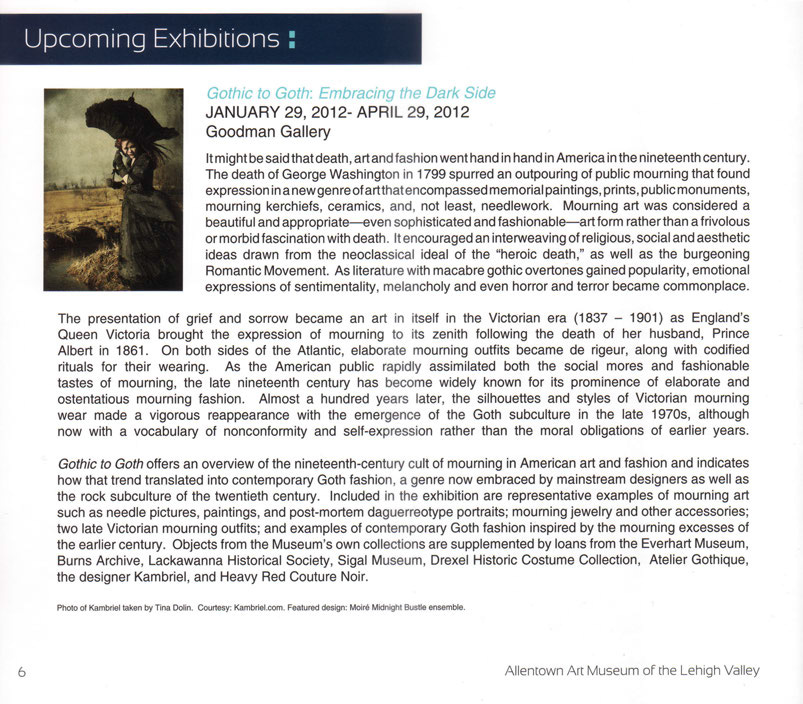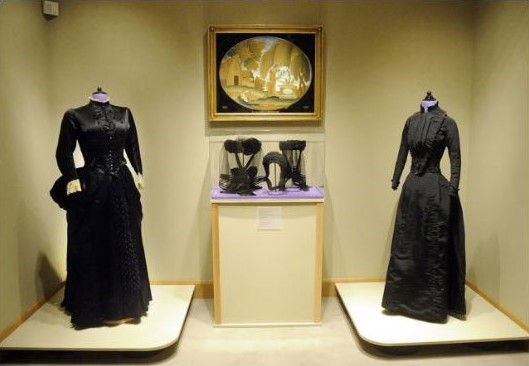From Gothic to Goth: Embracing the Dark Side
The Goodman Gallery at the Allentown Art Museum of Lehigh Valley
in Allentown, PA
Jan 29, 2012 - Apr 29, 2012


An exhibition at the Goodman Gallery of the Allentown Art Museum featuring the Kambriel Moiré Midnight Bustle Ensemble amongst other examples of current and antique clothing, jewelry, needlework, and artwork.
Gothic to Goth offers an overview of the nineteenth-century cult of mourning in American art and fashion and indicates how that trend translated into contemporary Goth fashion, a genre now embraced by mainstream couture as well as by the rock subculture of the twentieth century. Included in the exhibition are representative examples of mourning art such as needle pictures, paintings, and post-mortem daguerreotype portraits; mourning jewelry and other accessories; two late Victorian mourning outfits; and examples of contemporary Goth fashion inspired by the mourning excesses of the earlier century.

American Goth: Embracing the Dark Side
Allentown Art Museum
Goodman Gallery, January 29-April 29, 2012
This exhibition will trace the nineteenth century cult of mourning and explore its influence on the contemporary Goth sub culture.
Mourning became fashionable in the United States with the death of George Washington in 1799. Many works of art and objects were produced to commemorate the passing of American beloved first president. The death of George Washington became a popular subject for schoolgirl needle pictures.
Subsequently the topic of mourning became a favorite for works of art of the nineteenth century. On display will be the exquisite works of this genre from the Allentown Art Museum's permanent collection including works from the Folwell School in Philadelphia and the Moravian Seminary for Young Ladies in Bethelehem.
During the nineteenth century the death rate was extremely high. Three out of every twenty babies born would die before their first birthday. Life expectancy was forty two years. Young children were instructed in the meaning and rituals of death. Given these statistics one can imagine the frequency of seeing widows and other people in mourning attire for extended periods of time, sometimes in excess of two years for widows.
In 1861, with the death of England's Prince Albert, Queen Victoria brought the art of mourning to its zenith. All fashionable women quickly followed suit; this event spawned an entire industry. Though it was an expensive endeavor due to the complexities of proper mourning, even women of lesser means whose desire it was to honor their dead did their best to conform to these conventions.
With the advent of World War I in 1914 and the resulting flood of casualties the rigors and demands of Victorian mourning became overwhelming and began to lose favor and wane for the next several decades.
Fast forward to the 1970s when once again there was a trend brewing on both sides of the Atlantic: Punk Rock. Punk had an intense anti-establishment spirit that became a world-wide phenomenon. As Punk progressed into the 1980s, it began to diversify into a very dark sub genre, known as Goth Rock. Goth Rock featured dark introspective lyrics that often dealt with the subject of death. Accompanying the Goth Rock movement came a powerful fashion statement. Bands such as Siouxsie and the Banshees , Bauhaus, Ministry, and Joy Division used dark Victorian influenced imagery that evoked traditional mourning styles. The influence showed up both in their lyrics as well as their dress and makeup. Goth is a style that has endured for thirty years, which has informed and inspired such fashion luminaries as Alexander McQueen, John Galliano, Rick Owens, and Yohji Yamamoto. Goth embraces death with striking fearlessness.
In contrast, nineteenth century death was accepted as a very stark reality. However the consolation that came with deep religious conviction and belief that the dearly departed would now reside in heaven with God provided comfort and joy to the mourner.
Thus, these two distinct periods share an expression of grief and isolation and an acute awareness of the inevitability of death which is the common ground that all humanity treads upon.
To illustrate these two trends on view from the AAM's permanent collection will be nineteenth century schoolgirl needle pictures, mourning bonnets, and fans, hair jewelry, hair wreaths, chantilly lace and George Washington memorial objects.
Objects from the eighteenth through twenty-first centuries will be
on loan from the following lenders:
The Everhart Museum, Scranton, Pennsylvania
Drexel Historic Costume Collection, Philadelphia, Pennsylvania
The Sigal Museum, Easton, Pennsylvania
The Luzerne County Historical Society, Wilkes-Barre, Pennsylvania
The Burns Archive, New York, New York
Kambriel, North Carolina